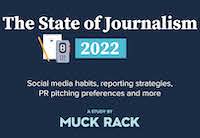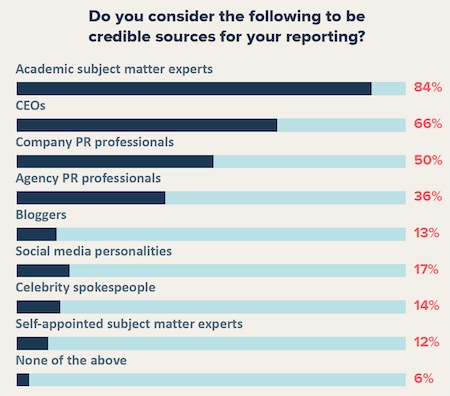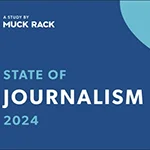 |
The number of journalists who see CEOs and company PR professionals as credible sources has dropped in the past year, according to a new survey from Muck Rack.
Both groups remain near the top of the list, but respondents to the “The State of Journalism 2022” gave them both lower marks than in the 2021 edition of the survey. While 84 percent of respondents said that CEOs were credible sources for their reporting last year, that number slid to 66 percent this year.
Company PR pros also saw a decline from 55 percent last year to 50 percent in the latest survey.
The most trusted source was “academic subject matter experts,” who were deemed credible by 84 percent of respondents.
Although social media personalities and celebrity spokespeople still lag behind more established sources, they are inching their way up. The trust level for social media personalities rose from 12 percent to 17 percent, and celebrity spokespeople are up to 14 percent from 12 percent.
A company’s social media is also becoming more important as a source for reporters. Well over half of respondents (60 percent) said they consult company-generated social media, up slightly from last year’s 58 percent.
When it comes to social networks, Twitter is the preferred platform by a long shot, with 77 percent saying that it is a valuable source in their work. Facebook ranks a distant second (39 percent), followed by LinkedIn (24 percent), Instagram (18 percent) and YouTube (16 percent).
Companies also seem to be getting up to speed with the methods they use to disseminate information. While 61 percent of respondents in 2021’s survey said that the way companies share information is outdated, that figure dropped to 44 percent this year.
The Muck Rack study also looked at how journalists respond to pitches. Almost a quarter (23 percent) of respondents said they were more likely to respond to pitches than last year. About six in ten (59 percent) said they were just as likely to respond to pitches, with only 18 percent saying they were less likely.
Pitches remain a major source for stories, with 80 percent of respondents saying that at least a quarter of their stories originates from pitches.
A big factor in making a pitch attractive, according to the survey respondents, is keeping it short. About seven in ten (68 percent) said they prefer pitches of 200 words or less. Journalists also prefer getting pitches early in the week, with Monday the favorite day by far.
“The State of Journalism 2022” surveyed 2,547 journalists from Jan. 4 through 25 of this year.



 Consumers who once demanded convenience now require consistent, multi-channel experiences that cater to them at every point. Brands must have a clear, audience-appropriate, and channel-specific voice across all platforms.
Consumers who once demanded convenience now require consistent, multi-channel experiences that cater to them at every point. Brands must have a clear, audience-appropriate, and channel-specific voice across all platforms. Employees at U.S. companies are experiencing high levels of burnout, but managers are lagging behind when it comes to their awareness of the problem
Employees at U.S. companies are experiencing high levels of burnout, but managers are lagging behind when it comes to their awareness of the problem Brand has a powerful effect on a company’s valuation, but the level of brand understanding in the investment community leaves a lot to be desired, according to a new study from Brodeur Partners, Interbrand and NewtonX.
Brand has a powerful effect on a company’s valuation, but the level of brand understanding in the investment community leaves a lot to be desired, according to a new study from Brodeur Partners, Interbrand and NewtonX. AI may still be viewed with a wary eye by most media pros, but its use is growing, according to a new study from Muck Rack.
AI may still be viewed with a wary eye by most media pros, but its use is growing, according to a new study from Muck Rack. A new study from Walker Sands says that some marketers have been putting the cart before the horse when it comes to the relationship between marketing channels and business outcomes.
A new study from Walker Sands says that some marketers have been putting the cart before the horse when it comes to the relationship between marketing channels and business outcomes.


 Have a comment? Send it to
Have a comment? Send it to 
No comments have been submitted for this story yet.